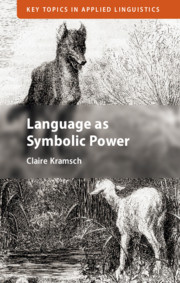Book contents
- Language as Symbolic Power
- Key Topics in Applied Linguistics
- Language as Symbolic Power
- Copyright page
- Contents
- Figures
- Acknowledgments
- Introduction
- Part I The Power of Symbolic Representation
- 1 “I Speak, Therefore I Am”
- 2 The Power of Symbolic Representation
- 3 Narratives of Power—The Power of Narrative
- Part II The Power of Symbolic Action
- Part III The Power to Create Symbolic Reality
- Conclusion
- Glossary
- Endnotes
- References
- Index
3 - Narratives of Power—The Power of Narrative
from Part I - The Power of Symbolic Representation
Published online by Cambridge University Press: 15 October 2020
- Language as Symbolic Power
- Key Topics in Applied Linguistics
- Language as Symbolic Power
- Copyright page
- Contents
- Figures
- Acknowledgments
- Introduction
- Part I The Power of Symbolic Representation
- 1 “I Speak, Therefore I Am”
- 2 The Power of Symbolic Representation
- 3 Narratives of Power—The Power of Narrative
- Part II The Power of Symbolic Action
- Part III The Power to Create Symbolic Reality
- Conclusion
- Glossary
- Endnotes
- References
- Index
Summary
This chapter is an illustration of the concepts encountered in the last two chapters. It compares the way children were socialized into good boys and girls and good citizens in the Germany of the nineteenth century, and in the United States of the 1930s and 1960s, by discussing what books young children were read to by their parents – Der Struwwelpeter in Germany, The Little Engine that Could and The Cat in the Hat in the United States. It makes apparent the different uses of symbolic power in the narratives of the time and how children are trained to respond to symbolic power and symbolic violence. I reflect on the power of narrative to shape young children’s understanding of the social reality they are growing up in and how narratives transmit values that bind families and communities together. I compare this use of narrative with present-day children’s books in the United States that move from moral prescriptivism to ethical perspectivism and multicultural consciousness. I discuss how the narratives that have held nations together are currently being dismantled by globalization, social media and divisive populist politics.
- Type
- Chapter
- Information
- Language as Symbolic Power , pp. 58 - 76Publisher: Cambridge University PressPrint publication year: 2020

